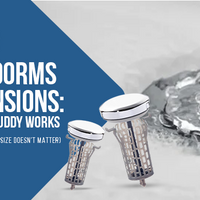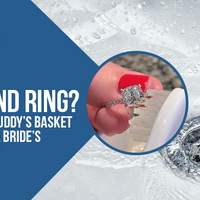We’ve all been there: standing in the shower, watching the water rise around our ankles, or waiting impatiently for the sink to drain after washing a few dishes. Clogged drains are one of the most frustrating and costly problems of homeownership.
Fortunately, many common causes of clogged drains can be prevented with proper knowledge and habits.
The most frequent culprits are hair, grease, and food waste. But while some clogs are simple, everyday problems, others signal bigger, structural issues that you need to watch out for. This guide will explore the top 10 causes of clogged drains and, more importantly, equip you with simple, effective habits to prevent them from occurring.
1: Hair
Hair is a major reason for clogged drains. When hair washes down the drain during a shower or bath, it intertwines with sticky soap scum, forming a stubborn, net-like blockage. This creates an unpleasant obstruction that ensnares other debris attempting to pass through the pipe.
Prevention
Use a drain cover or a hair catcher in every shower and tub. This is the simplest, most effective solution for bathrooms. Make it a habit to clean them regularly. A great example of a physical barrier that allows for easy debris removal is the Drain Buddy.
2: Grease, Fats, and Oil
Liquid grease might look harmless when it’s hot, but as soon as it hits the cool pipes, it solidifies. This sticky layer coats the pipe walls and acts like flypaper, trapping any food scraps or debris that tries to pass by. Over time, this leads to a complete blockage.
Prevention
Never pour grease, fats, or oils down the drain. Instead, wipe pans with a paper towel, pour cooled grease into an old jar or can, seal it, and throw it in the trash.
3: Food Waste
Though garbage disposals are convenient, they shouldn't be treated as trash cans. Food scraps, particularly starches such as pasta and rice, expand in water, while grounds and eggshells never dissolve. These items accumulate, forming a dense, sludgy blockage.
Prevention
Before washing dishes, scrape all food scraps into the trash or compost bin. Install simple sink strainers to catch any remaining small particles. Avoid putting coffee grounds, eggshells, or high-starch foods down the garbage disposal.
4: Soap Scum
Bar soap, especially when combined with hard water minerals, is a major cause of clogged drains. This combination creates a sticky soap scum that coats the inside of pipes, narrowing the drain and providing a surface for hair and other debris to cling to.
Prevention
Switch to liquid body wash, as it has fewer ingredients that can harden. To prevent sticky buildup, flush your drains monthly with very hot water or a baking soda and vinegar solution.
5: Foreign Objects & Non-Flushable Items
Most bathroom products, except toilet paper, are made to absorb water, not break down. Items like “flushable” wipes, cotton swabs, dental floss, feminine products, and even small toys can get trapped in pipes and cause tough clogs.
Prevention
The golden rule for your toilet is simple: Don't flush everything!
Place a trash can in your bathroom and teach everyone in your household to only flush toilet paper.
6: Mineral Buildup
Hard water areas can lead to mineral buildup, such as calcium and lime, within pipes. This gradual accumulation narrows the pipe's internal diameter over time, resulting in consistently slow drainage rather than a sudden blockage.
Prevention
The best long-term solution is to install a water softener in your home. For immediate maintenance, perform regular descaling with safe, non-corrosive cleaners.
7: Dirt and Debris
Washing off muddy shoes, cleaning dirty gardening tools, or having heavy rainfall can wash dirt, mud, and sediment down your drains. This heavy debris doesn't dissolve; it settles in the lowest sections of the pipe, leading to sediment buildup.
Prevention
Rinse off excess dirt and mud outside before entering the house. Also, make sure all outdoor drain covers are secure and clear them of debris regularly.
8: Toilet Paper Overuse
While toilet paper is designed to dissolve, using excessive amounts can overwhelm the drain flow before it has enough time to break down. This is especially true when using thicker, plush varieties..
Prevention
Use a reasonable amount of toilet paper, flushing twice if needed. If issues persist, consider switching to a thinner toilet paper.
9: Aging or Damaged Pipes
This is a structural issue. Old, corroded, or damaged pipes have rough interiors or low spots that naturally catch and hold debris. Over time, these spots collect waste and become the inevitable cause of frequent and frustrating clogs.
Prevention
For recurring clogs, a plumber can conduct a video inspection to check your pipes for any damage or rough areas. This type of issue necessitates professional intervention.
10: Tree Roots
Tree roots naturally seek moisture. If your underground sewer line has even tiny cracks or weak joints, the roots will infiltrate those openings. Once inside the pipe, they grow and expand, creating a massive blockage that requires significant professional intervention.
Prevention
Know where your sewer line runs before planting trees. Avoid planting large, thirsty trees nearby. If you have large trees near old lines, schedule regular professional camera inspections to catch root intrusion early.
FAQs About Clogged Drains
How does the Drain Buddy prevent hair and soap clogs?
Drain Buddy uses a built-in strainer basket that acts as a physical barrier, catching all shed hair and stopping it from combining with soap scum inside the pipe. This prevents the formation of those tough, net-like clogs.
Can Drain Buddy catch foreign objects like rings or earrings?
Yes! Its design allows it to act as a safety net. If small valuables like rings, earrings, or even cotton swabs accidentally fall into the sink, the Ultra Flo basket catches them instantly, keeping them out of the pipes.
Is it easy to clean the hair out of the Drain Buddy?
Absolutely. It features Pull Clean technology, meaning the basket lifts right out of the drain for quick debris removal. You don't need any tools or messy chemicals; you just pull it out, wipe the hair off, rinse, and drop it back in.
What should I do if I suspect tree root damage?
This is a serious issue that needs professional help immediately. Call a plumber to perform a video inspection. This camera check will confirm the location and severity of the root intrusion, allowing for targeted professional repair.
Conclusion
Prevention is always easier and cheaper than repair. By understanding these common causes, you can stop clogs before they start.
Use drain strainers like Drain Buddy in every sink, shower, and tub to catch debris, dispose of fats, oils, grease, wipes, and floss in the trash, and stick to flushing only toilet paper. Flush drains with hot water monthly or use a baking soda–vinegar treatment every few months to keep them clear. If blockages persist, schedule an annual inspection.
So, start today and save yourself from future plumbing emergencies!






